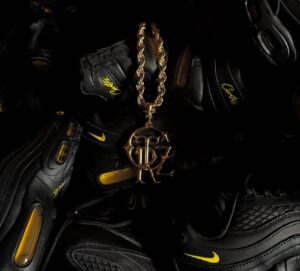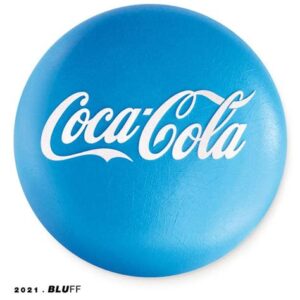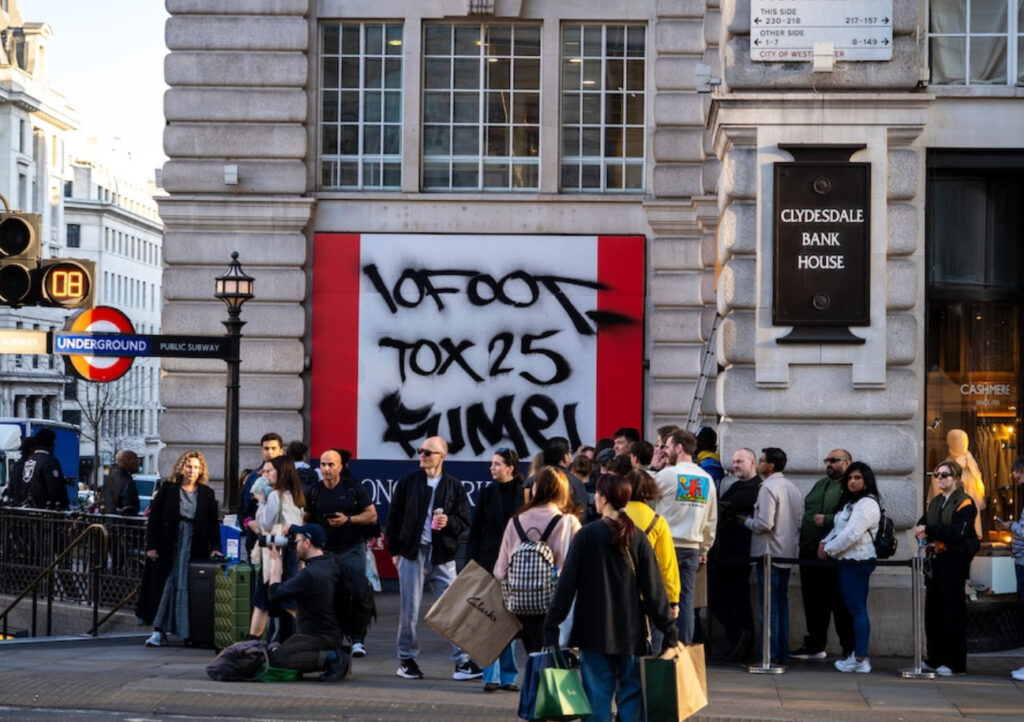
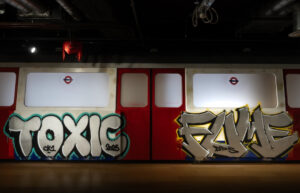
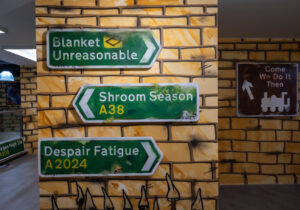
In the annals of London’s street art history, few names provoke as much reaction—admiration, outrage, nostalgia, defiance—as 10FOOT, TOX, and FUME. These artists, who emerged from the turbulent undercurrents of the UK graffiti scene, are as much myth as they are makers.
Their styles may differ, their legacies complicated, but all three share an origin story born in backdrops: train yards, underpasses, and the long, dark tunnels beneath the city.
Now, from March 21 through April 13, 2025, these three names return to the surface—not on shutters or signal boxes, but inside a formal art venue: 33 Regents Street, Saint James, London. The exhibition, titled Mind the Gap: Long Dark Tunnel, is not a celebration in the commercial sense. It is a confrontation, a reclamation, a slow-burn spectacle of paint, metal, and memory. And it is a rare moment when three of London’s most iconoclastic vandals—now cultural touchstones—occupy the same space by choice, not chance.
The Setting: Between Surfaces
33 Regents Street is a pristine address in a neighborhood more associated with bespoke tailoring than subway tagging. But this dissonance is part of the curatorial strategy. The exhibition opens not in a white cube but in a decommissioned railway access corridor—its concrete and steel preserved, its industrial acoustics intact. As you enter, there’s no welcome desk, just a flickering fluorescent light and the sound of a distant train rumble, recorded and looped for effect.
The viewer does not step into a gallery. They step into a memory of transit, of movement without destination. The walls are not repainted; they are retrofitted fragments of city infrastructure. And along these walls, interspersed with projections and metal relics, appear the works of 10FOOT, TOX, and FUME—tagged, painted, mounted, repurposed.
10FOOT: Syntax of Repetition
If graffiti is a language, 10FOOT is a student of its grammar. Known for the relentless repetition of his moniker in tightly spaced letters across London rooftops, overpasses, and train lines, 10FOOT has built a visual identity from consistency. His tag is less of a name and more of a mantra—an assertion of being that accumulates meaning the more it is repeated.
In Long Dark Tunnel, 10FOOT presents four full-size panels that mimic the sidewalls of a Jubilee Line tunnel. Each one is densely bombed with variations of his tag—black on grey, silver on rust, white on black. These are not canvases; they are repurposed trackside signal panels, collected over years, preserved and anonymized. His tag evolves into texture—sometimes neat, sometimes chaotic, always urgent.
One standout piece, “Don’t Blink (Section 17)”, features 137 tags across a single aluminum sheet, layered until they create a kind of optical hum. The piece is as meditative as it is aggressive, suggesting that repetition is not merely graffiti’s tactic—it’s its philosophy.
TOX: The Anti-Artist Turned Folk Symbol
Where 10FOOT cultivates form, TOX disrupts it. Arguably the most polarizing figure in the UK graffiti scene, TOX (Daniel Halpin) became famous—and infamous—for the raw simplicity of his tag: TOX + Year. From 2002 through 2011, his scrawl appeared everywhere—on bridges, utility boxes, station walls—often described as “lazy,” “meaningless,” or “non-aesthetic.” But in this seeming absence of style, TOX cultivated something powerful: presence.
In the exhibition, TOX embraces this minimalism unapologetically. A long wall installation titled “TOX2006—TOX2011” features six framed slabs of salvaged brick, each bearing his yearly tag. The exhibition does not sanitize or elevate the work—it simply presents it as artifact, complete with flaking paint, mildew stains, and rusted hardware.
What TOX reveals in this context is graffiti’s raw function as claim and timestamp. Like carving your name into a desk or tree, TOX’s tags insist: I was here. I’m still here. And through repetition, he becomes not just an artist—but a folkloric presence, like a ghost that keeps returning with the same signature, year after year.
FUME: Rhythm and Control
If TOX is chaos and 10FOOT is mantra, FUME is flow. A technician of letters and symmetry, FUME’s style emerges from the New York tradition of wildstyle, translated into the British vernacular. His name—short, sharp, and phonetically satisfying—lends itself to repetition, but unlike his co-exhibitors, FUME thrives on style variation.
Inside Long Dark Tunnel, FUME’s work is presented in backlit transparency, mimicking the effect of train tunnel graffiti illuminated by passing headlights. A central piece, “Northern Line Reversal”, features a multi-layered mural of his name deconstructed and reassembled—letter by letter—on plexiglass panels that rotate, allowing viewers to engage with the piece as a kaleidoscope of form.
Another highlight is a suspended installation of FUME tags painted directly on repurposed train parts—brake pads, wheel covers, ventilation fans—each treated as miniature canvases. The mechanical meets the lyrical, emphasizing that graffiti is not just mark-making, but mark-mechanizing—each piece engineered for maximum movement and rhythm.
Sound, Space, and Sentiment
Curated by a collaborative team of artists and ex-transit engineers, the exhibition includes a bespoke sound design track that merges field recordings of underground travel with ambient drone and low-frequency noise. Speakers are embedded behind wall panels, beneath grates, and inside metal ducts, creating a spatially immersive auditory map of the Tube. This soundscape underlines the work’s environmentality—it was born not in studios, but in transit. It belongs to the underworld.
Ambient projections loop footage of trains slowing into stations, lights flickering across graffiti-streaked walls, rats scuttling along tracks. But this is not romanticized. It’s clinical, archival, honest.
And yet, a quiet melancholy threads the experience. A small, tucked-away corner titled “The Lost Map” features a disintegrating blueprint of the London Underground from the early 2000s, annotated by hand, listing spots, access points, shutdowns, arrests. The wall around it bears scratched tags—some real, some archival recreations—fading into each other like names in a forgotten phonebook.
Public Enemy, Public Memory
What Mind the Gap makes clear is that the battle over graffiti has always been a battle over visibility and permission. 10FOOT, TOX, and FUME were branded as nuisances, criminals, “urban blight.” Their names were scrubbed from public view, even as they became part of collective memory.
This exhibition reframes that legacy—not as apology, not as commodification—but as critical memory work. These artists do not seek redemption. They seek recognition of graffiti’s function as resistance—to surveillance, to cleanliness, to urban amnesia.
And in doing so, Long Dark Tunnel transforms its space into a kind of temporary museum of the invisible—one where what was once scrubbed off is now preserved, what was once rushed is now examined, what was once vandalism is now voice.
Impression
As you leave Mind the Gap, the soundscape tapers. The final installation is a rusted “Mind the Gap” sign—real, not replicated—tagged by all three artists. It hangs above a hollow threshold with no exit, just a wall of mirrors reflecting the viewer infinitely. It is an echo chamber for all the names, the years, the loops of letters that define this scene.
No comments yet.







